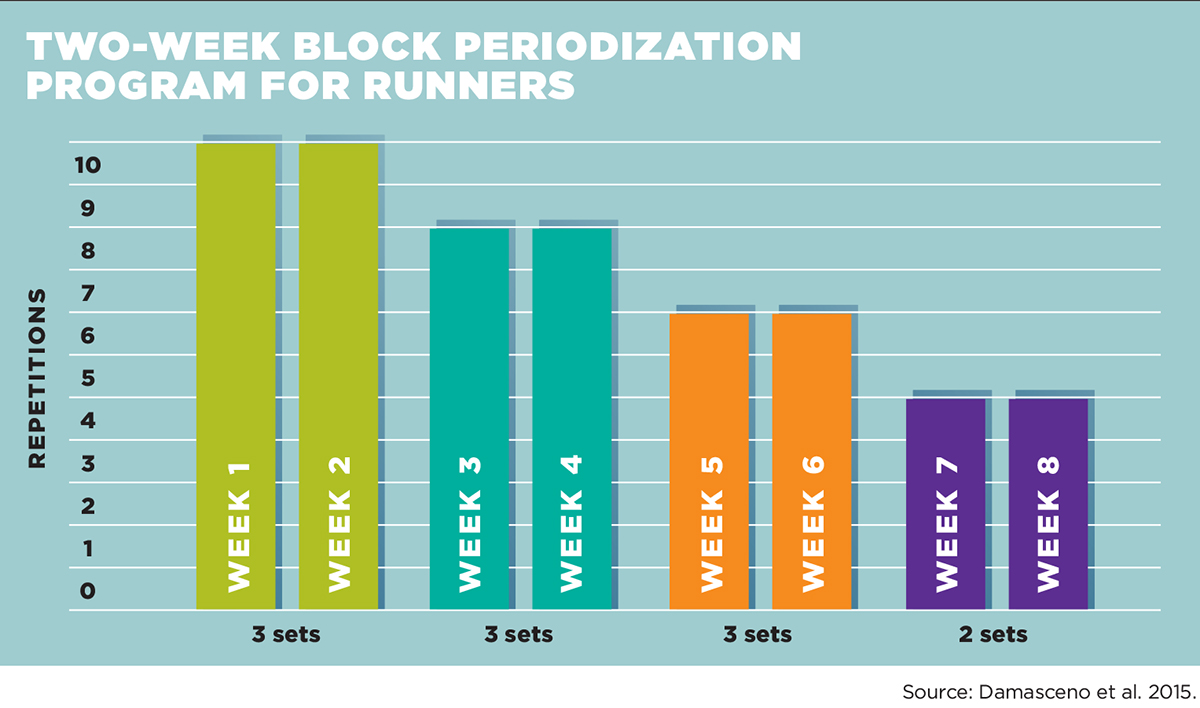Resistance Training for Runners Has Arrived
On your mark, get set—squat!

For decades, there has been an ongoing debate about whether runners can regularly add resistance training to their conditioning programs without impairing performance outcomes. And many fitness professionals, coaches and athletes are undecided: Can a strength and conditioning program actually improve running performance?
Beattie et al. (2017) explain that this uncertainty is most likely due to the “hypertrophic” undertones associated with distance running and lifting weights. These nuances mistakenly link strength adaptations to increased musculature and/or body mass, which would result in negative physiological outcomes for running performance.
Interestingly, in a recent publication on the habits of competitive runners in the United Kingdom, Blagrove et al. (2020) reported that out of 667 middle- and long-distance runners surveyed, 53.8% engaged in strength and conditioning to improve running performance. And 63.1% of the runners did strength and conditioning exercises to lower injury risk. Resistance training and plyometric training were employed by 62.5% and 35.1% of the racers, respectively.
This column presents a research review of what science says about the known performance benefits of resistance training for runners and provides evidence-based suggestions for what types of resistance training programs work best for competitive runners.
Concurrent Training Performance Outcomes

Strength training can improve muscular and explosive strength, running economy and speed.
A conditioning program that includes both strength and endurance training is often referred to as concurrent training (Trowell et al. 2020). In their systematic review and meta-analysis, Trowell and colleagues state that the benefits of concurrent training (compared with endurance training alone) relate to improvements in the force-generating capacity of the quadriceps, hamstrings, gluteal muscles and ankle plantar flexors. The study also cites several publications demonstrating that resistance training enhances the running economy of endurance athletes.
See also: Tapering for Resistance Training: Less Is More!
Research Review #1: The Effect of Strength Training on Performance Indicators in Distance Runners
In their 2017 study, conducted at the University of Limerick in Ireland, Beattie et al. investigated the effect of a 40-week (20-week preseason and 20-week in-season) strength training intervention on physiological performance indicators (speed at VO2max and running economy), strength qualities (maximal and explosive), and body composition in British collegiate and national-level distance runners (1,500–10,000 meters).
Runners were randomly divided into two groups. One group participated in an endurance training and strength training intervention (n = 11; age = 29 years), and a second group served as a control group, performing endurance training only (n = 9; age = 27 years). Curiously, none of the athletes in the intervention group had any resistance training experience.
In addition to their endurance training, intervention participants did strength training twice a week (60 minutes per session) during the preseason period (weeks 1–20) and once a week during the in-season “racing” period. All strength sessions were coached by an experienced, accredited professional.
The strength training intervention was designed as a 4-week block periodization that primarily included jumps, back squats, Romanian deadlifts and split squats. Throughout the 40 weeks, sets for the intervention group varied from 1 to 3, and repetitions varied from 4 to 12.
It is worth mentioning that the participants’ average VO2max was 61.3 milliliters per kilogram of body weight per minute, which is close to the physiological standard (65–75 ml/kg/min) for British national-level male distance runners.
The major finding of this study was that the strength training intervention group significantly improved muscular and explosive strength, running economy, and speed at VO2max. The control group showed no improvements in these parameters. In reflecting on the training program, the researchers highlight that limiting resistance training to once a week during the racing season proved to be very effective in helping to avoid overtraining, because the athletes were training at intense race speeds during this period.
Research Review #2: Effects of Resistance Training on Neuromuscular Characteristics and Pacing During 10-km Running Time Trial
Damasceno and colleagues (2015) investigated the effects of 8 weeks of resistance training in 18 runners randomized into (1) a running group that also did resistance exercise twice a week (n = 9; age = 34 years) and (2) a control group that ran but did no resistance training (n = 9; age = 33 years). The resistance training group followed a 2-week block periodization training program (see “Two-Week Block Periodization Program for Runners,” below) with 2–3 sets of four exercises (half-squat, leg press, plantar flexion and knee extension), targeting muscles considered to be dominantly recruited in running. Every 2 weeks, the periodization program increased in intensity and decreased in volume.
After 8 weeks, the running group showed significant im–provements in the half-squat one-repetition maximum, drop jump and peak treadmill speed. There were no changes in the control group. A noteworthy performance outcome was that runners who added resistance training showed higher speeds during the middle-to-last phases of the 10-kilometer running trial. Thus, the strength training provided a distinctive stimulus that helped to counteract fatigue during the last part of a 10-km running bout.
How Does Resistance Training Improve Running Performance?
Damasceno et al. propose two mechanisms that may explain how resistance training improves running performance:
- The researchers submit that, after a resistance training program, there is greater motor unit synchronization, which improves muscle contraction efficiency and coordination. This improvement also delays the onset of neural signals related to fatigue. Better contraction coordination may increase runners’ musculotendinous ability to rapidly absorb and create force against the ground as they run.
- The research team proposes that an increase in muscular strength results in greater recruitment of type I (aerobic) slow-twitch muscle fibers, delaying the recruitment of energy-
demanding type II (anaerobic) fast-twitch fibers. This physiological delay of fast-twitch fiber recruitment would result in runners having faster speeds over the last third of a race due to higher ATP availability for energy. Bazyler et al. (2015) describe this physiological phenomenon as an “anaerobic reserve” for late-race sprint performance—essentially a sparing of fuel substrate (i.e., carbohydrate) stores within a muscle.
See also: The 4 Most Common Running Injuries and How to Address Them
Developing a Resistance Training Program for Runners

Individualize a training program to a client’s goals, fitness level, time available for exercise, diet and competitive running events.
So how do you introduce resistance training to your running clients? Begin by dispelling any mistaken beliefs they have about resistance training being detrimental to runners (e.g., it will lead to bulky muscles that impede running performance). Share current research on the effectiveness of resistance training for runners, particularly emphasizing that it improves performance outcomes and is instrumental in injury prevention (Bazyler et al. 2015).
As you consider program design, be keenly aware that a “one-size-fits-all” resistance training program doesn’t exist. Individualizing a training program to a client’s goals, fitness level, time available for exercise, diet, work/school responsibilities, sleep and competitive running events will always result in the best results (Bazyler et al. 2015).
Also, depending on the client—and since many runners have not done much resistance training—teach basic movement patterns and positions (e.g., hip hinge, knee hinge, spine stability) and proper technique before you introduce any overload programming.
The evidence shows that endurance athletes need to develop muscular strength, anaerobic power and high-intensity exercise endurance, according to Bazyler et al. Their analysis of resistance training studies indicates that two training approaches elicit positive outcomes for endurance athletes: (1) maximal, high-force, low-velocity, strength training (HFLV) and (2) explosive, low-force, high-velocity strength training (LFHV).
A periodized training plan is a logical suggestion because it provides a systematic approach to maximize work with recovery, minimizing injury. A 2-week block periodization program was earlier presented by Damasceno and colleagues (2015). Bazyler and colleagues introduce a 4-week block periodization design with four distinct phases: strength-endurance, basic strength, strength and power.
For exercise selection, Bazyler et al. recommend prioritizing closed kinetic chain exercises because they require greater levels of intermuscular coordination and have been shown to produce greater performance outcomes than open-chain exercises.
Specific exercises to select include squats, split squats, back squats, half squats, Romanian deadlifts and lunges. The studies reviewed in this column suggest that having clients complete 1–3 sets of 4–12 repetitions, 1–3 times a week, is a good working range for an endurance-focused training plan. Also, as in the studies summarized in this column, including lower-body plyometric exercises is certainly running-specific to help develop explosive power.
It’s Time
Resistance training for runners has arrived. The evidence-based research indicates this is a fabulous training supplement for any recreational or competitive runner. Let’s get those clients squatting!
See also: Metabolism and Strength Training
Running Economy: Better Efficiency With Every Step
“Running economy is defined as the metabolic cost to cover a given distance at a constant velocity” (Beattie et al. 2017). Running economy research measures runners’ oxygen consumption and fuel utilization when running at specific intensities. Runners who are able to consume less oxygen (and spare carbohydrate usage) while running at a given velocity are said to have a better running economy.
References
Bazyler, C.D., et al. 2015. Strength training for endurance athletes: Theory to Practice. Strength and Conditioning Journal, 37 (2), 1–12.
Beattie, K., et al. 2017. The effect of strength training on performance indicators in distance runners. The Journal of Strength and Conditioning Research, 31 (1), 9–23.
Blagrove, R.C., et al. 2020. Strength and conditioning habits of competitive distance runners. The Journal of Strength and Conditioning Research, 34 (5), 1392–99.
Damasceno, M.V., et al. 2015. Effects of resistance training on neuromuscular characteristics and pacing during 10-km running time trial. European Journal of Applied Physiology, 115 (7), 1513–22.
Trowell, D., et al. 2020. Effect of strength training on biomechanical and neuromuscular variables in distance runners: A systematic review and meta-analysis. Sports Medicine, 50 (1), 133–50.
Len Kravitz, PhD
Len Kravitz, PhD is a professor and program coordinator of exercise science at the University of New Mexico where he recently received the Presidential Award of Distinction and the Outstanding Teacher of the Year award. In addition to being a 2016 inductee into the National Fitness Hall of Fame, Dr. Kravitz was awarded the Fitness Educator of the Year by the American Council on Exercise. Just recently, ACSM honored him with writing the 'Paper of the Year' for the ACSM Health and Fitness Journal.







